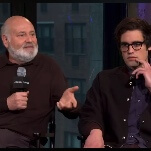“Twenty minutes into the future,” TV networks rule the world, essentially forcing their view of things onto the corporate serfs that make up the population. Rogue reporter Edison Carter (Matt Frewer) has a habit of pissing off his bosses, but he’s also a popular draw, so they allow him to live. But when he discovers a secret program to download people’s consciousnesses into computers, the bosses decide to have him killed, and he’s grievously injured in a motorcycle accident. In the aftermath, he’s downloaded into a computer, and his brain functions become Max Headroom, who is exploited by his bosses and turned into a TV host. (It’s surprising how much sense this makes onscreen.) From there, Max and Edison (who recovers) investigate corporate wrongdoing and fight back for the little people with the help of a trusty team—and a hefty side of satire, largely delivered by Max himself in late-night-comic mode.
The most thrilling part of Max Headroom is its weekly stabs at serialized world-building. It takes a while for the show’s ideas to catch up to its look, but once the series figures out a way to make the cheap appearance of the video it’s filmed on (meant to approximate the look of a live news broadcast) into a virtue instead of a liability, it’s capable of pulling off some startlingly beautiful shots. Edison will be off looking into some malfeasance, and in the background, the world will look like a nuclear junkyard, or the news van will sit atop a hill overlooking the city. There series occasionally over-relies on primitive computer graphics (particularly in the pilot), but the use of video, while jarring at first, eventually becomes key to its success.
Another key is Frewer in the central double role. He has a great time playing the weird duality of a man who quests for the forces of good in the physical world, and is all unleashed id and court jester in the virtual world. Frewer (who doesn’t appear in the set’s copious special features, sadly) turns both sides of the character into a sly examination of the way news may sit on one side of the coin, but entertainment is always on the other.
But the main thing that keeps Max Headroom fresh is the fact that the world it was only halfway beginning to sketch out now feels like the world we live in today. The notion of networks so all-powerful that they control what people do and think only feels like a half-joke in a world where many tune their opinions to whatever Fox News or MSNBC is saying at that moment, and the idea of network presidents turning the news into a comedy program also has a ring of truth. Max Headroom has a satiric, anarchic center, but it feels increasingly bleak and true. Networks looking for a series to remake or update might as well start here.
Key features: In typical Shout! fashion, there are a ton of featurettes on this set, all worth watching. Of particular interest is “Live on Network 23,” which digs deep into the character’s British roots and the split among the creative personnel over his voyages to America. (Annabel Jankel and Rocky Morton developed the character and his world in the UK, but George Stone was the one to take it to the U.S., over their protests.) There’s also an actors’ roundtable and a number of featurettes dealing with everything from the look of the series to the technology in the show’s world. Sadly, Shout! hasn’t included any of the original British variety-show segments or American TV commercials starring the character, nor the original British TV movie that introduced him.























![HBO teases new Euphoria, Larry David, and much more in 2026 sizzle reel [Updated]](https://img.pastemagazine.com/wp-content/avuploads/2025/12/12100344/MixCollage-12-Dec-2025-09-56-AM-9137.jpg)

















